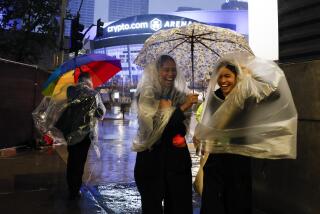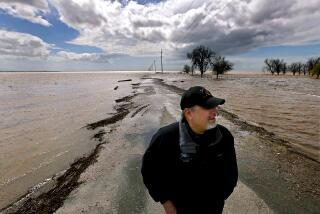‘Voluntary’ efforts not strong enough to combat California’s drought

<p>Gov. Brown today declared a drought emergency in the state, amid California’s driest year on record.</p>
California is officially in a drought. This is state’s driest year on record, and the National Weather said this week that the dry conditions will persist or get worse through April — meaning the rainy season won’t be rainy.
Gov. Jerry Brown declared a drought emergency Friday, saying “We ought to be ready for a long, continued, persistent effort to restrain our water use.”
But, he added, conservation efforts would be “voluntary.”
Voluntary?
It’s true that Californians are good at cutting water use during drought periods. In the past, residents have temporarily cut their water consumption by 10% to 25%. In Los Angeles, water use is still below 2007 levels (the last time there was a drought), suggesting conservation measures adopted during a drought may turn into habit.
But, if there is concern about a prolonged drought and there’s real uncertainty about the state’s water supply given the condition of the delta and the Colorado River and the impact of climate change, why rely on voluntary measures to conserve water?
If California wants to cut water use, look to the desert city of Las Vegas.
Sin City has enacted some of the strictest water-use policies in the nation. Nonresidential development cannot use grass for landscaping. Golf courses have a tight water budget to stay green. There are limits on the days and times you can irrigate. Water used indoors is recycled and returned to the water supply system.
Residents cannot plant new lawns in their frontyards nor use grass to cover more than half of the backyard. They’re not allowed to wash their cars with a hose more than once a week, and the hose must have a trigger-style spray nozzle. People caught wasting water by hosing down sidewalks or letting water from sprinklers leak into the street face fines starting at $80. Repeat offenders can be fined $1,200 to $5,100, depending on the size of the meter, and could have their water shut off.
As a result of those policies, Las Vegas has added some 400,000 residents but actually decreased water consumption.
Many cities in California, and most in the Southland, have adopted variations of Las Vegas’ conservation measures. But they’re temporary during a drought or rarely enforced. That’s not enough.
A carrot-and-stick approach to water conservation is smart. Financial incentives, such as paying people to remove lawns in favor of drought-tolerant landscaping, can help a lot. But California is all carrot and not enough stick. We could learn a few things from Las Vegas.
ALSO:
Killed for texting in Florida: What in the wired world is going on?
It took longer for Ohio inmate to die than it takes to read this post
Gov. Jerry Brown: Is he saving California or ruining it? The 9 big issues
Follow Kerry Cavanaugh on Twitter @kerrycavan and Google+
More to Read
A cure for the common opinion
Get thought-provoking perspectives with our weekly newsletter.
You may occasionally receive promotional content from the Los Angeles Times.











